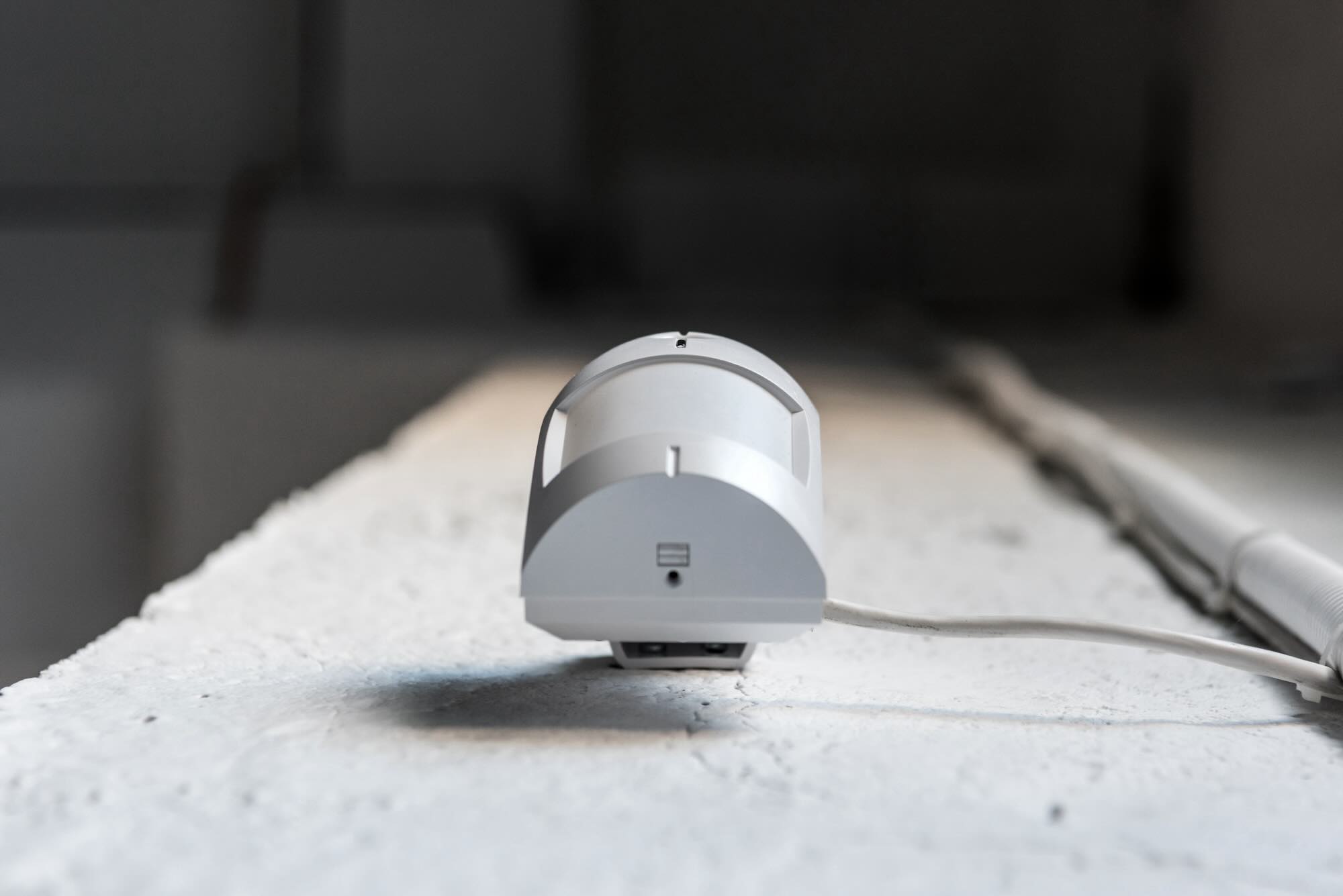Home>Home Security and Surveillance>How To Draw A Finite State Machine For An Intrusion Detection System


Home Security and Surveillance
How To Draw A Finite State Machine For An Intrusion Detection System
Modified: October 20, 2024
Learn how to create a powerful Finite State Machine for your Intrusion Detection System to enhance your Home Security and Surveillance.
(Many of the links in this article redirect to a specific reviewed product. Your purchase of these products through affiliate links helps to generate commission for Storables.com, at no extra cost. Learn more)
Introduction
Home security is a top priority for homeowners, and with the advancements in technology, there are now more options than ever to ensure the safety of your home and loved ones. One crucial aspect of home security is surveillance, which involves the use of cameras and monitoring systems to keep a watchful eye on your property. However, simply having surveillance cameras installed is not enough; you need a comprehensive and effective home security and surveillance system in place.
Intrusion detection systems play a vital role in ensuring the security of your home. These systems are designed to detect unauthorized access or intrusion attempts and immediately alert you or the authorities. They rely on sophisticated algorithms and sensors to monitor your premises and detect any suspicious activities.
In this article, we will delve into the intricacies of designing a finite state machine (FSM) for an intrusion detection system. A finite state machine is a mathematical model used to describe the behavior of a system by dividing it into sequential states and transitions between those states.
Understanding the concept of finite state machines is paramount in developing effective intrusion detection systems. By creating a FSM specifically tailored to your home security needs, you can optimize the detection and response process, ensuring maximum protection for your home.
In the following sections, we will provide a comprehensive guide on how to design a finite state machine for an intrusion detection system, covering everything from defining the states and transitions to implementing the actions and validating the system’s functionality. So, let’s dive right in!
Key Takeaways:
- Designing a finite state machine (FSM) for an intrusion detection system involves breaking down the security system into different operational modes, defining transitions between these modes, and implementing specific tasks or operations for each transition. This helps in creating a robust and effective security system that can adapt to different security scenarios and respond promptly to potential threats.
- Thoroughly testing and validating the FSM is crucial to ensure the effectiveness and reliability of the intrusion detection system. By conducting various tests, including unit testing, integration testing, edge case testing, and validations with real-world scenarios, you can optimize the performance and reliability of your security system.
Read more: How To Create Intrusion Detection System
Understanding Finite State Machines
A finite state machine (FSM) is a mathematical model used to describe the behavior of a system by breaking it down into a set of well-defined states and the transitions between those states. It is a powerful tool for modeling complex systems, and in the context of home security and surveillance, it can be utilized to create an effective intrusion detection system.
At its core, an FSM consists of three main components:
- States: These are the distinct conditions or modes that a system can exist in. In the case of an intrusion detection system, states could include “Idle,” “Armed,” “Alert,” or “Reset.”
- Transitions: Transitions represent the movement from one state to another. They are triggered by specific events or conditions. For example, when a motion sensor detects movement, it could trigger a transition from the “Idle” state to the “Alert” state.
- Actions: Actions are the tasks or operations performed when a transition occurs. They can include sounding an alarm, sending notifications, or activating additional security measures.
FSMs provide a structured and organized approach to system design. By defining states, transitions, and actions, you can effectively capture the behavior and response of the system in various scenarios. This allows for efficient decision-making and automation, reducing the complexity of manual intervention.
One of the key benefits of using finite state machines is their flexibility. The states and transitions can be defined and modified to suit the specific requirements of your intrusion detection system. Whether you have a small apartment or a large estate, FSMs can be customized to accommodate the unique layout and security needs of your property.
Another advantage of FSMs is their ability to handle complex interactions and dependencies between different states. By mapping out all possible states and their transitions, you can ensure that your intrusion detection system responds appropriately to different situations. This helps in the timely detection and mitigation of potential threats.
In the next sections, we will explore how to apply the concept of finite state machines to design an intrusion detection system for your home. We will discuss the various states, transitions, and actions that need to be considered, ensuring a comprehensive and robust system that maximizes the safety and security of your property.
Overview of Intrusion Detection Systems
Intrusion Detection Systems (IDS) are crucial components of home security and surveillance systems. They are designed to monitor and detect any unauthorized access or intrusion attempts within your premises. IDS can be classified into two main types: network-based and host-based.
Network-based IDS monitor network traffic flowing through your home network. They analyze network packets and look for patterns or signatures that indicate potential threats or suspicious activities. Network-based IDS can provide real-time monitoring and alerting, allowing you to take immediate action to mitigate any security risks.
On the other hand, host-based IDS focus on individual devices or hosts within your home network. They monitor the activities on specific devices, such as computers or smart home devices, and identify any abnormal behavior or unauthorized access attempts. Host-based IDS can provide detailed insights into the security of each device, enhancing overall protection.
Both network-based and host-based IDS work together to provide a comprehensive security solution for your home. By combining these two types of IDS, you can monitor network traffic and individual devices, ensuring maximum visibility and protection.
One key aspect of intrusion detection systems is the ability to classify and prioritize alerts. IDS employ various techniques, such as rule-based analysis, anomaly detection, and machine learning algorithms, to analyze and assess the severity of potential threats. This allows for the efficient allocation of resources and response mechanisms, ensuring that critical or high-risk alerts are prioritized and attended to promptly.
Additionally, intrusion detection systems can be enhanced through the integration of other security technologies, such as video surveillance cameras, motion sensors, and access control systems. By connecting these various components, you can create a holistic security ecosystem that provides a multi-layered approach to protecting your home.
Furthermore, modern intrusion detection systems often incorporate remote monitoring and mobile apps, allowing you to access and manage your system from anywhere. This gives you the flexibility to monitor your home’s security status and receive real-time alerts, even when you are away.
Overall, intrusion detection systems are an essential component of any home security setup. They provide continuous monitoring, real-time alerts, and enhanced protection against unauthorized access or security breaches. By deploying an effective intrusion detection system, you can have peace of mind knowing that your home and loved ones are safe and secure.
Designing the Finite State Machine for Intrusion Detection
Designing a finite state machine (FSM) for an intrusion detection system requires careful consideration of the system’s behavior, states, transitions, and actions. By breaking down the process into key steps, you can create an FSM that effectively captures the security requirements of your home.
Defining the States: The first step in designing the FSM is to identify and define the relevant states. These states should represent the different modes or conditions that your intrusion detection system can be in. Common states include “Idle,” “Armed,” “Alert,” and “Reset.” Each state should reflect the specific behavior and actions associated with it.
Determining the Transitions: After defining the states, the next step is to determine the transitions between them. Transitions are triggered by specific events or conditions. For example, a transition from the “Idle” state to the “Armed” state might be triggered when you activate the system using a security code or a mobile app. It’s important to carefully consider all the possible transitions and the events that trigger them.
Implementing the Actions: Actions define the tasks or operations that occur when a transition takes place. These actions can include sounding an alarm, sending notifications to your phone, activating additional security measures like locking doors, or contacting the authorities. It’s essential to identify the appropriate actions for each transition to ensure a comprehensive response to potential threats.
When designing the FSM, it’s crucial to keep the specific security requirements of your home in mind. Consider factors such as the layout of your property, the number of entry points, and the types of sensors and surveillance equipment you have installed. This will help you tailor the FSM to accurately reflect the behavior and response of your intrusion detection system.
While designing the FSM, it’s also important to consider scalability and flexibility. Your home security needs may evolve over time, requiring adjustments to the FSM. By designing a flexible FSM, you can easily accommodate future modifications or enhancements without substantial changes to the overall system.
Moreover, it is worth mentioning that design considerations should also include issues like false positives and false negatives. Strive to strike a balance between sensitive detection and minimizing false alarms to ensure that the intrusion detection system is reliable and dependable.
By carefully defining the states, transitions, and actions, you can create a finite state machine that accurately represents the behavior of your intrusion detection system. This FSM will provide a solid foundation for the operation and automation of your home security and surveillance system.
Defining the States
Defining the states is a crucial step in designing a finite state machine (FSM) for an intrusion detection system. States represent the distinct conditions or modes that your system can exist in, and they play a critical role in determining the behavior and actions of the system.
When defining the states for your intrusion detection system, consider the various operational modes that your system can have. Here are some common states to consider:
- Idle: The system is in a passive state, not actively monitoring or detecting any potential threats. This state typically occurs when you have deactivated the intrusion detection system.
- Armed: The system is active and ready to monitor for any suspicious activities. This state occurs when you have enabled the intrusion detection system.
- Alert: The system has detected a potential intrusion or security threat. This state indicates that there is an ongoing security event that requires attention and immediate action.
- Reset: The system has been disarmed or the security threat has been resolved. This state is triggered after the alert state when the system returns to normal operation.
These are just some example states that you can consider for your intrusion detection system. The actual states will depend on the specific requirements and functionality of your system.
It’s important to define each state with clarity and specificity. Consider what actions or behaviors are associated with each state. For example, in the “Armed” state, the system might be actively monitoring sensors, recording video footage, and updating the central control panel. On the other hand, in the “Alert” state, the system might sound alarms, send notifications, and activate additional security measures.
In addition to the primary states, you may also want to include transitional states that represent intermediate conditions. These transitional states can capture activities such as system initialization, sensor calibration, or performing integrity checks. They provide a more granular representation of the system’s behavior and can be helpful in enhancing the overall functionality and reliability of the intrusion detection system.
Defining the states with precision is essential for creating a clear and accurate representation of your intrusion detection system in the form of an FSM. Each state should encapsulate the necessary information about the behavior, actions, and conditions associated with it. This will lay the foundation for designing the transitions and actions that govern the system and enhance its ability to detect and respond to potential threats.
When drawing a finite state machine for an intrusion detection system, start by identifying the different states the system can be in, such as “idle,” “detecting intrusion,” and “alerting.” Then, define the transitions between these states based on the system’s behavior and inputs.
Read more: How To Test Intrusion Detection System
Determining the Transitions
Determining the transitions is a critical step in designing a finite state machine (FSM) for an intrusion detection system. Transitions represent the movement from one state to another and are triggered by specific events or conditions. By carefully defining the transitions, you can accurately capture the behavior and response of your system to various situations.
When determining the transitions for your intrusion detection system FSM, consider the events or conditions that would cause a change from one state to another. Here are some examples of common transitions:
- Arming: This transition occurs when you activate the intrusion detection system, moving from the “Idle” state to the “Armed” state. It can be triggered by entering a security code, using a mobile app, or pressing a physical button.
- Disarming: This transition occurs when you deactivate the intrusion detection system, moving from the “Armed” state to the “Idle” state. It can be triggered by entering a security code, using a mobile app, or pressing a physical button.
- Intrusion Detected: This transition occurs when the system detects an intrusion or security breach, moving from the “Armed” state to the “Alert” state. It can be triggered by a sensor detecting motion, a door/window being opened without authorization, or any other suspicious activity.
- Alert Resolved: This transition occurs when the security threat has been resolved or when the user acknowledges and responds to the alert, moving from the “Alert” state to the “Reset” state. It can be triggered by entering a security code, using a mobile app, or confirming the situation is a false alarm.
These are just a few examples of transitions that you may consider for your intrusion detection system FSM. The actual transitions will depend on the specific functionalities and requirements of your system.
When determining the transitions, it is crucial to think about the conditions or criteria that must be met for each transition to occur. For example, the transition from the “Armed” state to the “Alert” state may have conditions such as multiple sensors detecting activity or a specific sensor detecting a specific type of breach.
Additionally, it’s important to consider the sequencing and dependencies of transitions. Certain transitions may be dependent on the current state or other transitions that have already occurred. Designing the FSM with a logical sequence of transitions ensures the system responds appropriately to different situations and maintains the integrity of the overall security framework.
An effective intrusion detection system FSM should encompass all possible transitions and the corresponding events or conditions that trigger them. By accurately determining the transitions, you can create a comprehensive and responsive system that adapts to security threats and provides timely alerts and actions.
Implementing the Actions
Implementing the actions is a crucial aspect of designing a finite state machine (FSM) for an intrusion detection system. Actions define the tasks or operations that are performed when a transition occurs. By carefully implementing the actions, you can ensure an effective response to potential threats and enhance the overall security of your system.
When implementing the actions for your intrusion detection system FSM, consider the specific actions that need to be taken based on each transition. Here are some examples of common actions:
- Sounding an alarm: When transitioning to the “Alert” state, your system may trigger auditory alarms, alerting you and potentially deterring intruders.
- Sending notifications: When transitioning to the “Alert” state, your system may send notifications to your smartphone or email, providing real-time updates and alerts about the security breach.
- Activating additional security measures: When transitioning to the “Alert” state, your system may initiate further security measures, such as locking doors, activating outdoor lights, or triggering video recording.
- Contacting authorities: In the “Alert” state, your system may automatically contact local authorities or a security monitoring service, ensuring a swift response to the security breach.
- Providing status updates: Your system may use actions to update the central control panel or display relevant information about the current state, giving you an overview of the security status of your home.
These are just a few examples of actions that you can implement in your intrusion detection system FSM. The actual actions will depend on the specific functionalities and capabilities of your system.
When implementing the actions, it’s crucial to consider the sequencing and timing of these actions. Some actions may need to occur simultaneously, while others may require a specific order or delay. Designing the FSM with well-coordinated actions ensures a cohesive and efficient response to security threats.
In addition to the immediate actions, you may also consider implementing delayed actions or timed sequences. For example, when transitioning from the “Alert” state to the “Reset” state, your system may delay deactivating alarms or additional security measures for a specific period, allowing you to confirm the situation and prevent false alarms.
Furthermore, it’s essential to consider the integration of actions with other security components. Your intrusion detection system may be connected to video surveillance cameras, motion sensors, or access control systems. Implementing actions that coordinate with these components maximizes the effectiveness of your security measures.
By carefully implementing the actions for your FSM, you can create an intrusion detection system that responds effectively to security breaches. Each action should align with the specific requirements and goals of your system, ensuring the safety and protection of your home and loved ones.
Testing and Validating the Finite State Machine
Testing and validating the finite state machine (FSM) for your intrusion detection system is a crucial step to ensure its effectiveness and reliability. By thoroughly testing and validating the FSM, you can identify any potential issues or gaps in the system’s behavior and make necessary adjustments.
Here are some steps to consider when testing and validating your FSM:
- Unit Testing: Start by conducting unit tests for each individual state and transition in isolation. This involves carefully designing test cases to assess the expected behavior of each state and transition. These tests help ensure that each component of the FSM functions correctly and performs the intended actions.
- Integration Testing: Once the individual states and transitions have been tested, proceed to integration testing. Test the entire FSM as a whole, including the interaction between different states and transitions. This ensures that the FSM functions cohesively and seamlessly in real-world scenarios.
- Edge Case Testing: It’s essential to test your FSM with various edge cases and unusual scenarios. These tests simulate uncommon conditions or unexpected inputs to ensure that your intrusion detection system can handle them appropriately. Examples of edge cases could include intentionally triggering false alarms or simulating sensor failures.
- Validation with Real-World Scenarios: To validate the effectiveness of your FSM, conduct tests using real-world scenarios. This includes simulating different security breaches and monitoring the response of your intrusion detection system. Measure the system’s performance in terms of response times, accuracy of alerts, and the ability to mitigate potential threats.
- Iterative Refinement: Based on the results of the tests and validations, iterate and refine your FSM. Identify areas where improvements can be made, such as adjusting the thresholds for triggering transitions, optimizing actions, or enhancing the overall logic of the system. Continuously refine and test the FSM to achieve a robust and efficient intrusion detection system.
In addition to functional testing, consider validating your FSM against security requirements and industry standards. Ensure that your intrusion detection system complies with relevant regulations and guidelines.
When testing and validating your FSM, document the test cases, results, and any modifications made to improve the system. This documentation serves as a reference and provides a clear record of the testing process.
Lastly, periodically review and retest your FSM to ensure its ongoing effectiveness. As technology evolves and new security threats emerge, it’s important to stay vigilant and update your intrusion detection system accordingly.
By conducting rigorous testing and validation of your FSM, you can optimize the performance and reliability of your intrusion detection system. This enhances the overall security of your home and provides peace of mind knowing that your system is capable of effectively detecting and responding to potential threats.
Conclusion
Designing a finite state machine (FSM) for an intrusion detection system is a crucial step in maximizing the security and protection of your home. By breaking down the system into well-defined states, determining transitions, implementing actions, and thoroughly testing the FSM, you can create a robust and effective intrusion detection system.
The concept of FSMs provides a powerful framework for capturing the behavior and response of your security system. States represent the different operational modes of the system, transitions define the movement between states, and actions dictate the tasks performed when a transition occurs.
Understanding finite state machines can help you design a system that adapts to different security scenarios, responds promptly to potential threats, and provides real-time alerts and notifications. It enables automation, enhances decision-making capabilities, and improves the overall efficiency of your intrusion detection system.
Throughout the design process, consider the layout and specific security requirements of your home. Tailor the FSM to accurately reflect the behavior and response of your system, ensuring maximum coverage and protection. Address issues such as false positives and false negatives to strike a balance between sensitivity and reliability.
Thoroughly test and validate your FSM through unit testing, integration testing, edge case testing, and validations with real-world scenarios. Continuously refine and improve your FSM to adapt to evolving security threats and industry standards.
By implementing a well-designed and thoroughly tested FSM, you can have peace of mind knowing that your intrusion detection system is equipped to detect, respond to, and mitigate potential security breaches. You are taking proactive steps to safeguard your home and loved ones.
Remember, home security and surveillance are crucial aspects of modern living, and designing an effective intrusion detection system is an investment in the safety and well-being of your household. Stay vigilant, keep abreast of the latest technologies and best practices, and continually evaluate and enhance your security measures.
Frequently Asked Questions about How To Draw A Finite State Machine For An Intrusion Detection System
Was this page helpful?
At Storables.com, we guarantee accurate and reliable information. Our content, validated by Expert Board Contributors, is crafted following stringent Editorial Policies. We're committed to providing you with well-researched, expert-backed insights for all your informational needs.














